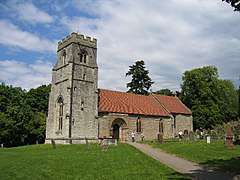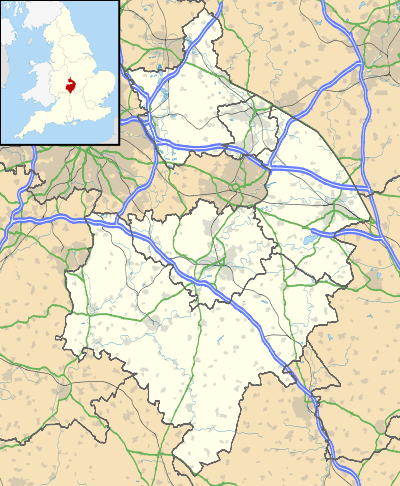Beaudesert, Warwickshire
Beaudesert (pronounced /ˈbɛlzər/[1][2]) is a village and civil parish in the Stratford-on-Avon district of Warwickshire, England, half a mile east across the River Alne to the north and west of Henley-in-Arden, to which it is closely associated and shares a joint parish council with.[3] The main village, consisting of the church and a single short street of houses, stands close to the river and directly opposite Henley Church. Behind the village to the east rises the hill, locally known as 'The Mount', crowned with the earthwork remains of Beaudesert Castle of the De Montforts.[4] According to the 2001 census it had a population of 919,[5] increasing to 990 at the 2011 Census.[6]
| Beaudesert | |
|---|---|
 St Nicholas Church | |
 Beaudesert Location within Warwickshire | |
| Population | 990 (2011census) |
| OS grid reference | SP1566 |
| Civil parish |
|
| District |
|
| Shire county | |
| Region | |
| Country | England |
| Sovereign state | United Kingdom |
| Post town | HENLEY-IN-ARDEN |
| Postcode district | B95 |
| Dialling code | 01564 |
| Police | Warwickshire |
| Fire | Warwickshire |
| Ambulance | West Midlands |
| UK Parliament | |
History
The village is not mentioned in the Domesday Book but is now thought to have been included in the entry for Preston Bagot, as part of the lands of the Count of Meulan, Robert of Beaumont, who had inherited Meulan through his mother. The portion recorded there appears without doubt to have been the present-day Beaudesert.[4] It was believed to have been anciently known as Donnilee, the name implying the place of a fort;[7] however recent writers such as the Victoria County History[4] have refuted this and Donnelie is now reckoned to be Honiley in the latest editions of the Domesday Book. Cooper wrote, "Beaudesert does not occur in the Domesday Book and Dugdale[8] conjectures that the place Donnele is identical with it, but recent investigation does not support this view".[9]
Beaudesert is the name given to it by the Norman family that settled here, meaning "the beautiful waste". The Domesday Book entry states; "In Ferncombe Hundred, in Prestetone (Preston Bagot), 5 hides. Hugh holds from him. Land for 3 ploughs. In lordship 1/2 plough; 2 slaves; 1 villager and 3 smallholders with 1 plough. The value was 30s; now 40s. Brictnoth held it freely before 1066".[10]
The Manor passed from the Count of Meulan to Henry de Beaumont, 1st Earl of Warwick, who enfeoffed his great-nephew Thurstan, the first of the De Montforts of Beaudesert, and the builder of the castle.[4] About the year 1140, Thurstan obtained from the Empress Matilda the right to hold a market on Sundays at his castle of Beaudesert.[8] He was succeeded by his son Henry, who died in 1191 and then by his son, Thurstan[8] who, dying in 1216, was succeeded by his son Peter, a minor, and who became a ward of William de Cantelupe of Aston Cantlow; it was this association which led him to later side with the Barons.[1] Peter de Montfort became the most powerful of all the De Montforts and in him the family was at the height of its glory. Peter obtained on, 10 February 1227 the grant of a market on Monday and a yearly fair at his manor of Beaudesert to be held on 'the eve, feast, and morrow of St. Giles'. In the Barons' wars he sided against the king, Henry III and was one of those who formulated the Provisions of Oxford in 1258. He was taken prisoner at Northampton, but was released and following the Peace of Canterbury was elected one of the council of nine. He was killed fighting beside his kinsman Simon de Montfort, although the exact relationship is not known,[2] at Evesham in 1265.[4] His eldest son Peter was taken prisoner at Evesham and placed in the custody of Thomas de Clare, to whom his forfeited lands were granted, but shortly afterwards he was pardoned and his lands restored to him. The manor then descended to his son John and then to his son, John who was aged 5 at his father's death, in 1296, and named as heir to the castle of Beaudesert. This John was concerned in the execution of Piers Gaveston, but was afterwards pardoned and died fighting for the king at Bannockburn in 1314.[4][8]
John left no issue, Beaudesert and Henley passed to Peter his brother who, had one son named Guy, married to Margaret daughter of Thomas de Beauchamp, Earl of Warwick. In 1349, the manor and castle of Beaudesert and the manor of Henley were settled on Guy with contingent reversion to the Earl of Warwick. Guy died in 1361, before his father, without issue, so after Peter de Montfort's death the manors reverted to the Earl of Warwick, who died in 1369. His son Thomas granted the manors to his brother William de Beauchamp, 1st Baron Bergavenny for life in 1376. At his death in 1410 they were divided between William Boteler of Sudeley and Baldwin Freville, son of Sir Baldwin Freville, who were descended from sisters of the last Peter de Montfort.[4]
Notable buildings
The parish church, dedicated to St Nicholas was built in 1070 and despite restoration in the 19th century still contains many Norman parts.[1] The chancel and south wall of the nave including the fine south doorway are Norman, the north doorway is also of this date but the north wall is later, the width of the nave having been reduced from its original width, as it cuts into the Norman chancel arch.[11] The tower, of the 15th century, again is smaller than may be expected and not centred on either the original nor revised axis of the nave. This may be due to parsimony or the instability of the ground, this instability may be the reason for moving the north wall, all of which leave a number of unsolved architectural issues.[12] The chancel roof, which appears to be a fine piece of Norman vaulting is really an addition of the 19th century, certainly after 1846, probably in 1869.[1] Much of the stained glass is by Morris & Co.[12] Of the six ringing bells (previously an unringable ring of three bells but restored and augmented in October 2013 by redundant bells from other towers)[13] [14] there are three historic bells: one inscribed "ave maria gratia pelan", another "ihesvs nazsarinvs rex ivdeorvm", both in Lombardic capitals; they date from about 1350. A third is dated 1711, by Joseph Smith of Edgbaston.[4][15]
It is most notable for the ruined Beaudesert Castle.
Notable people
- Richard Jago, the poet, was born in 1715 at Beaudesert Rectory, Henley in Arden where his father Richard was rector. Educated at Solihull Grammar School, one of the houses is named after him, where he met another minor poet William Shenstone. From there he went to University College, Oxford where he took his MA in 1738 having been made curate at Snitterfield the previous year. He became vicar of Harbury in 1746 and shortly after Chesterton both in Warwickshire followed by Snitterfield in 1754 where he took up residence until his death in 1781. Lord Willoughby de Broke presented him with the rectory at Kimcote in Leicestershire in 1771 and he resigned Harbury and Chesterton keeping Snitterfield and Kimcote. His best known poem is the long topographical, Edge Hill (1767).[16]
- William Booth, who was hanged for forgery in 1812 was born at Hall End Farm near Beaudesert and baptised there on 21 February 1776.[17] One of eight children of a farmer and church warden, John Booth, and his wife Mary.[18] He is the subject of the song "Twice Tried, Twice Hung, Twice Buried" by John Raven.[19] He converted the top floor of his farmhouse in Great Barr, Birmingham into a workshop where he produced forgeries of coins and banknotes.[20] He was caught, tried at Stafford Assizes[21] and sentenced to hang.[20] Booth's execution was bungled, and he fell through the scaffold's trap door, to the floor,[18] however, within two hours, he was hung again and died.[19]
References
- Highways and Byways in Shakspeares Country, Hutton 1914
- In the Forest of Arden, John Burman, 1948
- Henley-in-Arden | Beaudesert and Henley-in-Arden Joint Parish Council | Warwickshire | Archived 20 April 2001 at the Wayback Machine
- A History of the County of Warwick, URL: http://www.british-history.ac.uk/report.aspx?compid=56979 Date accessed: 24 November 2011.
- "ONS Neighbourhood statistics". Archived from the original on 29 May 2015. Retrieved 2 May 2007.
- "Civil Parish population 2011". Retrieved 23 December 2015.
- J. Tom Burgess, Historic Warwickshire: Its Legendary Lore, Traditional; Stories and Romantic Episodes, 1876
- William Dugdale, The Antiquities of Warwickshire, 1656
- W. Cooper, Records of Beaudesert, 1931
- Domesday Book for Warwickshire, Phillimore edited by John Morris ISBN 0-85033-141-2
- Old Warwickshire Churches, W Hobart Bird 1936
- Nikolaus Pevsner and Alexandra Wedgwood, The Buildings of England, Warwickshire, 1966, ISBN 0-14-071031-0
- "Beaudesert". Coventry Diocesan Guild of Church Bellringers. Retrieved 31 January 2014.
- "Beaudesert". Dove's Guide for Church Bellringers. Retrieved 31 January 2014.
- Tilley and Walters, Church Bells of Warwickshire
- Warwickshire People and Places, John Burman, 1936
- Warwickshire, England, Church of England Baptisms, Marriages, and Burials, 1535-1812 William Booth, son of John and Mary Booth, Baptised 21 Feb 1776 in Beaudesert, Warwickshire, England
- Booth, John N. Booths in History. p. 39.
- "Twice Tried, Twice Hung, Twice Buried". Retrieved 8 November 2011.
- "Booth's Farm". Digital Handsworth. Birmingham City Council. Archived from the original on 3 April 2012. Retrieved 8 November 2011.
- "William Booth by an unknown artist". Digital Handsworth. Birmingham City Council. Archived from the original on 3 April 2012. Retrieved 8 November 2011.
Further reading
- Beaudesert, Eng. (Parish) (1931). The Records of Beaudesert, Henley-in-Arden, Co. Warwick. Leeds: J. Whitehead & Son Ltd.
